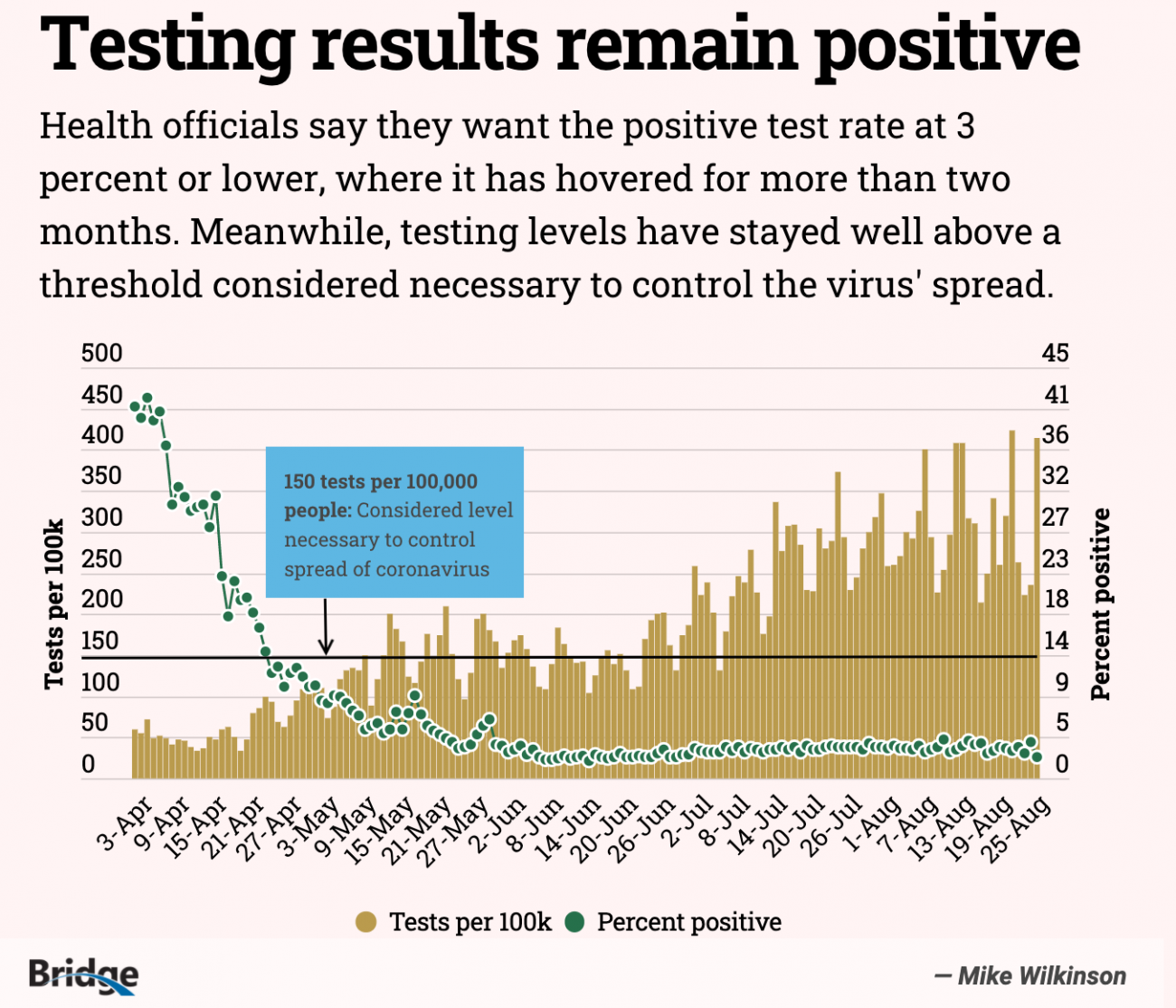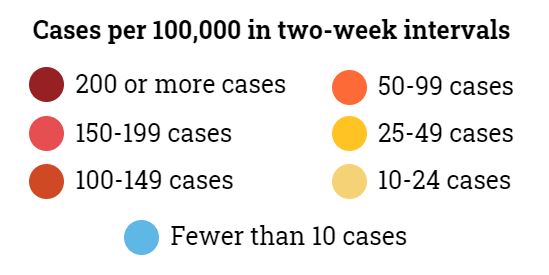Michigan nears 100K coronavirus cases. Maps, graphics show pandemic’s path.

Michigan is on the cusp of an unwanted milestone in the coronavirus pandemic, recording nearly 100,000 cases in the virus that has sickened tens of millions across the globe and caused over 830,000 deaths.
As of Thursday, Michigan had 99,958 cases, a staggering number for a virus first confirmed in the state on March 10. Since then, it has killed more than 6,400 residents and left more than 1 million jobless as Gov. Gretchen Whitmer shut businesses and schools in an effort to control the virus.
In the past weeks, the number of daily cases has fallen dramatically, after Whitmer restricted movement of people, limited the size of gatherings and ordered masks in public.
Related stories:
- The latest: Michigan coronavirus unemployment, map, curve, updated COVID-19 news
- Dashboard: Michigan coronavirus testing numbers, trends, COVID-19 data
Here’s a brief, data-based review of how the pandemic has played out since March in Michigan.
Where did it start, where did it go
When the virus first exploded, it was rooted in southeast Michigan for reasons that aren’t known (although the region has a large international airport and is home to about half the state’s residents). In the first few weeks in March, 80 percent of the state’s cases were in Wayne, Oakland and Macomb counties, with Detroit being a big enough hot spot that it attracted concern from the White House.
But since then, and over weeks and months, the virus spread, expanding to every corner of the state, from Monroe near the Ohio border to Copper Harbor in the far northwestern Upper Peninsula.
Virus’ spread over time
This map shows how coronavirus infections swept across the state, with darker colors representing higher rates of infection in two-week increments beginning in mid-March. The case counts were adjusted for population.

Source: Michigan Department of Health and Human Services
West Michigan saw its highest case counts in July, as metro Detroit had a respite. And now, some of the most dense cases are in the remote western Upper Peninsula, in Menominee County.
Though small in population, Menominee has averaged six new cases a day, or 26 for each 100,000 people, by far the highest current rate in the state. In comparison, Macomb County, which had the most cases on Wednesday (138), has had a daily average of 13.5 cases for every 100,000 people.
Who is getting the virus
Across Michigan, people of color and older residents have borne the brunt of the virus.
African Americans, who comprise 14 percent of the state population, make up nearly 40 percent of deaths and have a death rate — deaths per 1 million — that at 1,650 is nearly four times higher than it is for white residents (423 per million). (Data for other groups weren't available.)
The age gap revealed how deadly COVID-19 remains for the elderly: 16 percent of all coronavirus cases have hit those 70 or older but that age group makes up 70 percent of all deaths.
And the toll was especially harsh in nursing homes, where a third of all deaths, just over 2,100, have occurred among residents, and 21 nursing home employees have died.
Younger residents have been contracting the virus lately. Through June 5, about 4 percent of all infections were among those under 20 years old.
From then until this week, they have made up over 17 percent of new infections and they are the fastest rising age group contracting coronavirus in the state, even though they are the least likely to suffer serious complications.
Cases and deaths
By almost any measure, Michigan has rebounded from an awful — and deadly — beginning of the pandemic.
When probable cases are added to confirmed ones, Michigan has nearly 6,700 deaths, or 67 for every 100,000 people, a rate that is 10th highest in the nation. But it had been as high as fourth until waves of the virus swept through the south and southwest.
Michigan, which ranks 10th among states in overall population, ranks 18th in total coronavirus cases. It has been passed by several states, including Ohio, that for several weeks had far fewer cases than Michigan.
By population, Michigan now ranks 37th in terms of cases per 100,000 people.
Testing
Early on, Michigan struggled to test enough people and the few tests available were limited to those with symptoms and who had been in contact with a known coronavirus case.
Because of that, nearly 40 percent of tests were positive in the early weeks of the pandemic. A steady increase in testing capacity now has the state testing as many as 400 people per day per 100,000 — far surpassing the one-time goal of 150 tests.
That’s important, health experts say, because it allows public health officials to quickly identify cases and recommend quarantine for the infected. That works even better, they say, when the positive test rate is below 5 percent or, the Harvard Global Health Initiative suggests, even 3 percent.
By those standards, Michigan has done well: Over the past week 3.1 percent of tests are positive and on Wednesday just 2.4 percent of over 41,000 tests were positive.
Nationwide, 6.1 percent of cases are coming back positive, according to the Washington Post.
That includes places like Mississippi (22 percent positive in the last seven days), South Carolina (22 percent) and Iowa (16 percent). In states including New York, New Jersey, Connecticut, Rhode Island, Vermont, Washington and New Hampshire, fewer than 1 percent of tests are positive.
Hospitalizations
At the beginning of the pandemic, public officials across the country feared coronavirus patients would overwhelm hospitals.
And in Michigan, metro Detroit hospitals were crushed by the onslaught of patients, with nearly 4,000 people in Michigan hospitals in early April. It was one of the reasons for Gov. Gretchen Whitmer’s stay-at-home order and the talk of “flattening the curve” so those who did get sick could also get care.
It worked. Hospital admissions for COVID-19 plummeted steadily from April to around 400 in late June. It’s ticked up since but has largely hovered at 650 confirmed and suspected cases since.
According to the Washington Post, Michigan has seven people hospitalized for every 100,000 in the state, putting it in the bottom half of states and well below the 29 people in Mississippi, 26 in Nevada and 22 in Alabama for every 100,000 people.
New tool for next phase
As the pandemic continues to upend the lives of almost everyone in the state, and as residents are asking questions about whether face-to-face schooling, or a trip to the mall, is safe, Bridge Michigan offers a new tool to see how cases and testing are trending in every county.
The graphic shows the daily case count, as reported to the state, for every county, as well as seven-day average and cases per 100,000 and how that rate has changed from the previous week.
It also allows a glimpse at testing for each county (and Detroit): What are the positive test rates? Are they rising? Is there enough testing to ensure safety? It will be added to the Bridge Michigan dashboard as well.
See what new members are saying about why they donated to Bridge Michigan:
- “In order for this information to be accurate and unbiased it must be underwritten by its readers, not by special interests.” - Larry S.
- “Not many other media sources report on the topics Bridge does.” - Susan B.
- “Your journalism is outstanding and rare these days.” - Mark S.
If you want to ensure the future of nonpartisan, nonprofit Michigan journalism, please become a member today. You, too, will be asked why you donated and maybe we'll feature your quote next time!








